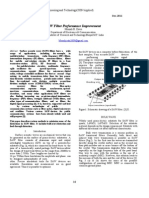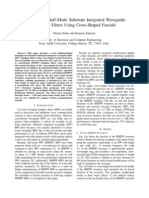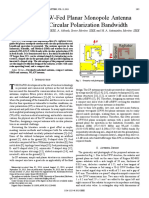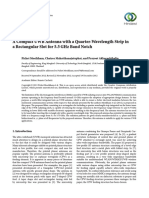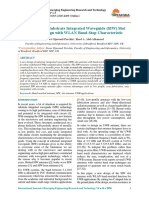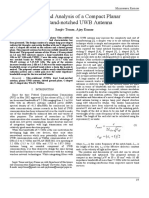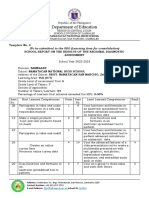Professional Documents
Culture Documents
Design and Realisation of Miniaturisation of Substrate Integrated Waveguide (SIW) - Based Bandpass Filter (BPF) at L-Band Frequency
Original Title
Copyright
Available Formats
Share this document
Did you find this document useful?
Is this content inappropriate?
Report this DocumentCopyright:
Available Formats
Design and Realisation of Miniaturisation of Substrate Integrated Waveguide (SIW) - Based Bandpass Filter (BPF) at L-Band Frequency
Copyright:
Available Formats
Volume 8, Issue 1, January – 2023 International Journal of Innovative Science and Research Technology
ISSN No:-2456-2165
Design and Realisation of Miniaturisation of
Substrate Integrated Waveguide (SIW)-Based
Bandpass Filter (BPF) at L-band Frequency
Abdullah Bazergan1, Muhammad Mimsyad2, Sirmayanti3 Yuliana Rauf4
1,2,3 4
Department of Electrical Engineering Department of Research and Regional Development
Politeknik Negeri Ujung Pandang Government of South Sulawesi Province
Makassar, Indonesia Makassar, Indonesia
Abstract:-This paper studies a miniaturization of a become an issue which has been attractive largely many
substrate-integrated waveguide (SIW) bandpass filter researchers. It offers a new structure in BPF design. The
(BPF) using only a square cavity. This cavity is to be smaller size make bandpass SIW filter very suitable for
loaded with a multi-sector circular patch, where each some applications such as satellite communication and radar
sectored patch is connected to the bottom surface of the systems. In addition, it possess highly integration capability
cavity through a shorting blind via. Each of the with other planar structures. The SIW-based BPF can be
shorting-via loaded sectored- patches and the cavity’s fabricated in a single layer or multilayer employingprinted
top and bottom surfaces form a resonator. Hence, circuit board (PCB) or low temperature cofired ceramic
multiple resonators can be housed in a single square (LTCC) technology [2]. For the time being, trisection BPFs
cavity and then are fed properly to construct a multi- on the basis of SIW have been reported in [3] using the
pole BPF. For easy integration with surrounding circuit circular cavity and in [4–5] using the rectangular cavity.
components, itis to be considered by only the case These filters employ three cavities as resonators to construct
where the cavity is fed with the coplanar waveguide a trisection BPF, while input and output resonators are
(CPW) rather than the coaxial cable. The downshifts in cross-coupled. Nevertheless, the SIW’s working frequency
the resonance frequency of the proposed resonator is in respect to the physical size of the component.
structure for the different number of sectors obtained Therefore, one of the SIW’s shortcomings is still its larger
from a complete cicuit patch are studied. BPFs dimension than that of the planar counterparts (e.g.,
constructed using one, two, and threesectored patches microstrip line).
are designed and compared. A sample BPF using three
sectored patches is fabricated and measured. As For circuit-size reduction purpose in BPF design, there
compared with the third-order BPF using three empty have been many efforts to miniaturize SIW-based BPFs.
SIW cavities, the size reduction rate of the fabricated Miniaturization techniques can be conducted using a half of
one is up to 98%. A good agreement is obtained conventional SIW, so-called HMSIW, while still
between simulated results and those measured. maintaining its characteristics [6–7]. The further reduction
of HMSIW results in a quarter of conventional SIW named
Keywords:- Miniaturization; trisection bandpass filter quarter-mode SIW (QMSIW) whereas reserving its original
(BPF), SIW characteristics as well [8]. Both of these techniques are to
reduce physical dimensions of SIW resonators. The sense of
I. INTRODUCTION miniaturization is not only the size reduction but also the
resonant frequency decrease. In the latter case,
Nowadays, a various of emerging wireless miniaturization is able to be achieved by loading the SIW
communication systems is developing rapidly. One of the by means of capacitive and inductive loading in order to
most important devices for wireless communication systems make it to work below its cutoff frequency as exhibited in
is a filter to minimize interference by passing a frequency [9–10], respectively. In both of these cases, the SIW’s size is
band of interest. It is a device which serves to select and/or still same as the conventional one, however, its resonant
reject specific frequency channels. High-performance frequency is shifted downward from the fundamental mode
filtering is critical since spectral crowding increases the need frequency. In [11], another miniaturization process is
for interference mitigation. Interference mitigation will proposed for which the SIW cavity (SIWC) consists of three
necessitate out-of-band attenuation. The such out-of-band metal layers and two substrate layers. The circular patch is
attenuation is able to be provided by bandpass filters (BPFs). located in a sandwiched middle metal layer so that results in
In general, a waveguide is used for designing a BPF with a large loading capacitance between the circular patch and
respect to a high selectivity and Q-factor. Disadvantages of the top/bottom SIWC walls.
the waveguide BPF are the size of the filter which is bulky
and costly as well. This paper is to study a miniaturization design of the
substrate-integrated waveguide (SIW) multi-resonator
More than a decade ago, a laminated waveguide (also bandpass filter (BPF) using only a square cavity on the basis
termed the substrate integrated waveguide, SIW), which is of the proposed structure in [11].
composed of a substrate with via-hole rows emulating the
waveguide’s side walls, was proposed [1]. Since then, it
IJISRT23JAN1188 www.ijisrt.com 1385
Volume 8, Issue 1, January – 2023 International Journal of Innovative Science and Research Technology
ISSN No:-2456-2165
II. RESONATOR DESIGN The resonance frequency of the resonator is primarily
determined by the SIWC’s loading capacitance, while the
Fig. 1(a) shows the proposed basic resonators to obtain loading capacitance is mainly contributed by the region
a miniaturized SIW cavity bandpass filter (BPF) which bounded by the middle patch and the top SIWC wall due to
consists of three 0.035-mmthick metal layers, two substrate small thickness [11]. On the other hand, the inductance
layers, and a thick prepreg (PP) as shown in Fig. 1(b). The section is established by the shorting blind via. Fig. 2
prepreg material is to be introduced for the binding purpose exhibits that the proposed resonator structure results in the
between the middle metal layer and the top substrate. electric field uniformly on the surface of the middle metal.
Basically, the middle metal layer is a circular patch, which As a result, the resonance frequency of the proposed
can be divided into some parts identically in order to obtain resonator can be greatly lowered from that of a standard
the desired filter order and each part is further connected to patch-free SIWC resonator, and among these basic
the ground by means of a shorting blind via as depicted in resonators, full circular patch resonator has the lowest
Figure 1(a). All metal layers are considered as copper, resonance frequencyas can be seen in Fig. 3. However,
meanwhile substrate layers are made of Rogers RT/Duroid lowering the dimension of the middle metal as a single
5880 (𝜖𝑟 = 2.2, tan 𝛿 = 0.0009) with different thickness of resonator by sectioning the full circular patch into some
whichthe top substrate hashtop = 0.254 mm and the bottom sections will increase the resonance frequency of the
substrate hash bottom = 1.58 mm. The SIW square-shaped resonator. It makes sense that lowering the dimension of the
cavity resonator occupies an area of 25 x 25 mm 2 with middle metal is to decrease loading capacitance, in turn, it
which a fundamental mode, TE101, exist around 5.67 GHz. will increase the resonance frequency of the resonator as
These parameters and dimensions are to be implemented to described in [11].
study and design BPFs with the different order.
Meanwhile, by modifying the location of the shorting
blind via from the cavity center, the resonance frequency of
the resonator will be increased so that for the fine tuning
purpose, one
Fig. 1: Shape of middle metal layer dan resonator structure; (a) various shapes of middle metal layer; (b) cross-section of
resonator structure
IJISRT23JAN1188 www.ijisrt.com 1386
Volume 8, Issue 1, January – 2023 International Journal of Innovative Science and Research Technology
ISSN No:-2456-2165
Fig. 2: E-field distribution inside the middle metal layer shown in Fig. 1 at the corresponding resonance frequency
Fig. 3: The resulted resonance frequencies of the basic resonators at various positions of the shorting blind via from the cavity
center can adjust shorting blind-via position. In addition, as depicted in Fig. 4, increasing the thickness of the bottomsubstrate will
decrease the resonance frequency of the resonator. In contrast, increasing the thickness of the top substrate will also increase the
resonance frequency. Shortly, lowering the thickness of the top substrate and increasing the thickness of the bottom substrate will
increase the miniaturization factor. However, these means will be restricted by available materials and allowable fabrication
limits.
Fig. 4: Effect of the substrate thickness on the resonance frequency
III. FILTER DESIGN length of the CPW and maintaining the width of the CPW and
other dimensions constantly, as depicted in Fig. 5(b). The Qe
A. One-Pole Bandpass Filter value can be extracted by the singly-loaded expression [12]
The proposed one-pole filter along with its dimensions is
obtained by employing the full patch shape of the middle metal Qe=f0/Δf±900(1)
as exhibited in Fig. 5(a). In order to design a such filter, the
dimensions of the square SIW cavity can be obtained as where f0 denotes the simulated resonance frequency,
described in [11]. The unloaded Q factor,Qu, of the proposed while Δf±900represents the frequency difference between phase-
structure is 221. The structure is excited by using coplanar shift +900 and phase-shift −900 occuring in the S11 phase
waveguide (CPW) structure. Therefore, the required external response.
quality factor (Qe) can be controlled by varying the inner-strip
IJISRT23JAN1188 www.ijisrt.com 1387
Volume 8, Issue 1, January – 2023 International Journal of Innovative Science and Research Technology
ISSN No:-2456-2165
Fig. 5: One-pole bandpass filter; (a) the proposed structure, (b) External quality factor (Q e) of the one-pole BPF vs. inner-strip
length
Fig. 6: Simulated S-parameter response of the one-pole bandpass filter
By using Qe value of 22 which is realized by the inner- B. Two-pole Bandpass Filter
strip length of 7.9 mm, Fig. 6 exhibits the S-parameter Fig.7 shows the proposed structure of the two-pole BPF
response of the one-pole BPF. As can be seen that the center using the proposed half patch resonator with its associated
frequency is 0.888 GHz. The return loss is better than 30 dB, dimensions. The structure implements magnetic coupling
whereas the insertion loss is 0.45 dB. The 3-dB fractional among resonators. This coupling is caused by the induced
bandwidth is 9.08%. The entire size of the proposed one- currents on the shorting blind vias. Actually, electric
pole filter is 0.01 𝜆2𝑑 where 𝜆d is the wavelength in the couplingexists between adjacent edges of the half patches.
medium of the dielectric material at the operating frequency. However, electric coupling between them is very weak. This
is because the top substrate is so thin that the electric field is
strongly bound in the region between each half patch and the
top SIWCwall. As a result, the coupling among them is the
dominated magnetic coupling, and is established by the
shorting blind via.
Fig. 7: The proposed structure of the two-pole BPF
IJISRT23JAN1188 www.ijisrt.com 1388
Volume 8, Issue 1, January – 2023 International Journal of Innovative Science and Research Technology
ISSN No:-2456-2165
In order to design a such BPF, once the resonator is As shown in Fig.8, the strong coupling can be
dimensioned, one can follow the conventional procedure by achieved when the distance between two shorting blind vias
determining the design values of the low-pass are in the close proximity. In other hand, the weak coupling
Butterworth/Chebyshev prototype response on the basis of can be obtained by making larger distance between them.
the specification target. On the basis of the coupled- Roughly speaking, it is possible to control coupling
resonator filters design, the general coupling matrix is coefficient by adjusting distance between two blind vias.
implemented to represent the employed coupling topology. The horizontal distance between the two shorting blind vias
Therefore, the relationship between coupling coefficients or can be employed for coarse adjustment of the coupling
external quality factors and physical dimensions of the coefficient, meanwhile the vertical distance can be used for
coupled resonators must be established. In this case, spacing fine tuning purpose.
of the two shorting blind vias represents the physical
dimensions, and is employed to derive the proper coupling. With the coupling coefficient of 0.0193 between two
The simulation is carried out by providing weak coupling resonators and external quality factor of 21.47, the proposed
for the input/output. The values of the simulated coupling two-pole BPF has S-parameter response as shown in Fig.9.
coefficient are extracted by the well-known expression [12] The center frequency is 1.258 GHz. The return loss is better
than 25 dB, whereas in-band insertion loss is 2.1 dB. The 3-
k = ± {[(f1)2 – (f2)2] / [(f1)2 + (f2)2]} dB fractional bandwidth is 2.6%. The proposed two-pole
(2) BPF provides an out-of-band rejection better than 20 dB and
30 dB up to 4.7721 and 4.7698 GHz, respectively. The
where f1 and f2 represent the high and low resonant unloaded Q factor,Qu,of the structure is 214. The overall
frequencies, respectively, and k denotes the value of size of the proposed two-pole BPF, excluding CPW feed
coupling coefficient between two resonators in terms of the lines, is 0.024 (𝜆d)2.
distance between two shorting blind vias. In addition, k > 0
and k < 0 indicate magnetic and electric couplings, C. Three-pole Bandpass Filter
respectively. Fig. 10 exhibits the structure and its associated
dimensions of the proposed SIWC three-pole BPF. Such
As with the one-pole BPF, the required external filter is well-known as a trisection BPF using one-third
quality factor (Qe) can also be controlled by the inner-strip patch as the basic resonator. The proposed trisection BPF is
length of the CPW at the input/output, and can be extracted a central reflection-type resonator as reported in [13].
by using (1). In order to turn out the relationship between
the physical dimensions and the required theoretical design
values, the coupling coefficient as a function of the spacing
between the shorting blind vias, and the external quality
factor value as a function of the inner-strip length is plotted
in Fig.8(a) and (b), respectively.
Fig. 8. (a) Coupling coefficient vs. distance between two blind vias in allignment, (b) External quality factor vs. inner-strip length
Fig. 9: Simulated S-parameter response of the two-pole BPF
IJISRT23JAN1188 www.ijisrt.com 1389
Volume 8, Issue 1, January – 2023 International Journal of Innovative Science and Research Technology
ISSN No:-2456-2165
A such structure introduces a cross coupling between k13indicate coupling coefficient of resonator 1 and 2 and
the first resonator in terms of the input resonator and the cross coupling, respectively.
third resonator in terms of the output resonator. Therefore,
there are two possible paths from input to output. As a Again, in order to design a such filter, one can follow
result, the structure introduces one TZ in its response. The procedures which are described in the sub section B. Fig.
associated TZ occurs near the upper edge of the passband. 11(a) shows the relationship between the coupling
This TZ is to improve the selectivity performance of the coefficient and the physical dimensions of the filter in terms
filter. Its asymmetrical response benefits some applications of the distance between two blind vias of the resonators. The
requiring higher selectivity only on one side of the passband. larger coupling coefficient values can be obtained by
The derived TZ is able to be related to coupling coefficients shortening the distance between two blind vias with respect
as follows [13] to the direction perpendicular to the edge of the patch. Fig.
11(b) describes the relationship between the external quality
fz = f0 + (f0 / 2)(k12)2/k13 (3) factor for resonator 1 and the inner-strip length of CPW,
while the other dimensions of the CPW are maintained to be
where fz and f0 represent the frequency of transmission same as Fig. 10. Eventually, the tuning processes must be
zero and the center frequency, respectively, whereas k12 and carried out to obtain an optimal response.
Fig. 10: The proposed structure of the trisection SIWC BPF; (a) top metal layer, (b) middle metal layer, (c) bottom metal layer
Fig. 11. (a)Coupling coefficient vs. distance between the adjacent shorting vias of the resonators, (b) External quality factor vs.
inner-strip length
The simulated S-parameter response is shown in Fig. between the middle metal layer andthe top substrate for the
13. It can be seen that the trisection BPF has the higher binding purpose. The fabricated structure is shown in Fig.
selectivity performance than one-pole and two-pole BPFs 10 and Fig. 12. The inset of Fig. 13 shows the measured and
with which a transmission zero appears closely to the simulated narrowband S-parameter responses of the
passband at upper side of stopband due to cross coupling proposed SIWC trisection BPF, whose photos are given in
between the first and the third resonators. The unloaded Q Fig. 14. The measured results are in good agreement with
factor,Qu,of the proposed structure is 216. Hence, for the simulated ones.
fabrication purpose, our concern is only for the trisection
BPF. As mentioned in the sub section C, there is a
transmission zero nearby upper edge of the passband, and it
D. Fabrication Results can be seen clearly that the proposed structure reflects its
The designed trisection BPF is realized by using three type as reported in [13]. The such transmission zero will
0.035-mmthick metal layers and two substrate layers. The sharpen one side of the passband skirt. The measured and
top and bottom Rogers RT/Duroid 5880 substrate layers the simulated in-band minimum insertion loss of the
with dielectric constant εr = 2.2 and loss tangent tanδ = proposed BPF are 2.9 dB and 1.95 dB,respectively.
0.0009 have the thicknesses of 0.254 and 1.58 mm, Meanwhile the measured and the simulated 3-dB fractional
respectively. A 0.08-mmthick prepreg (PP) layer with bandwidth (FBW) are
dielectric constant 4 and loss tangent 0.013 is placed
IJISRT23JAN1188 www.ijisrt.com 1390
Volume 8, Issue 1, January – 2023 International Journal of Innovative Science and Research Technology
ISSN No:-2456-2165
Fig. 12: Cross-section of the fabricated trisection BPF
Fig. 13: The measured and simulated S-parameter responses of trisection BPF
3.97% and 4% with the center frequencies of 1.612 much better area efficiency than those of the others. In
and 1.6 GHz, respectively. The measured and the simulated particular, the occupied circuit area of our proposed BPF is
transmission zero are 1.66 and 1.65 GHz. These values 0.04 d2 , which is much smaller than the area of 2 d2
approach the value obtained by using (3) as large as 1.648 required by a regular patch-free three-cavity SIWC
GHz. trisection BPF, that is, miniaturization factor of 98% can be
From Fig. 13, the measured high-end stopband BW is achieved. In addition, our circuit design yields the largest
2.69 and 3.04 GHz under the criterion of insertion loss upper stopband fractional bandwidth (FBW) with the
greater than 30 and 20 dB, respectively, corresponding to an criterion of S21≤20dB.
upper stopband fractional bandwidth (FBW) of 166.873%
and 190%. In order to exhibit our structure superiorities,
Table 1 provides comparison between our work and related
SIWC trisection BPFs. In this table, the datum with a tilde
sign in front denotes that such a datum is not given in the
reference paper, but is estimated by us using curves or other
relevant data available. Clearly, our circuit design has a
Fig. 14: Fabricated trisection BPF; (a) top view, (b) bottom view
IJISRT23JAN1188 www.ijisrt.com 1391
Volume 8, Issue 1, January – 2023 International Journal of Innovative Science and Research Technology
ISSN No:-2456-2165
Circuit Insertion loss FBW Upper-stopband FBW (%)
size ( 2d ) (dB) (%) (S21≦20 dB)
[2] 0.126 2.4 ~6 NA
[3] ~2.6 2.9 1.5 NA
[4] 0.511 1.15 5.8 ~20
[5] ~0.98 2.46 1.95 >43
This work 0.04 2.9 3.97 190
IV. CONCLUSION integrated waveguide (HMSIW) bandpass filter,”
IEEE Microw. Wireless Compon. Lett., vol. 17, pp.
This paper has already studied and shown a 265-267, April 2007
miniaturization design of the bandpass filters (BPFs) on the [7.] M.-H. Ho and C.-S. Li, “Novel balanced bandpass
basis of substrate integrated waveguide technology. The filters using substrate integrated half-mode
proposed structure provides a miniaturization factor of 98% waveguide,” IEEE Microw. Wireless Compon. Lett.,
in trisection BPF which is the highest record as long as the vol. 23, pp. 78-80, February 2013
author knowledge. The excitation structure using CPW [8.] S. Moscato, C. Tomassoni, M. Bozzi, and L.
provides the advantage of being easy for integration with Perregrini, “Quarter-mode cavity filters in substrate
other planar circuit. The circuit design and performance are integrated waveguide technology,” IEEE Trans.
verified by measurement, and it shows a good agreement Microw. Theory Tech., vol. 64, pp. 2538-2547,
with the simulation. The fabricated BPF can provide the August 2016
center frequency of 1,6 GHz which is at L-band frequency. [9.] Y. D. Dong and T. Itoh, “Susbtrate integrated
Hence, this device is capable of being utilized for radar waveguide loaded by complementary split-ring
application at L-band .The slight discrepancy between the resonators and its applications to miniaturized
measurement insertion loss and the simulation insertion loss waveguide filters,” IEEE Trans. Microw. Theory
comes from the effect of practical errors due to fabrication Tech., vol. 57, pp. 2211-2223, September 2009
as well as SMA connector loss. [10.] L. Riaz, U. Naeem, and M. F. Shafique,
“Miniaturization of SIW cavity filters through stub
ACKNOWLEDGMENT loading,” IEEE Microw. Wireless Compon. Lett.,
The authors wish to acknowledge the support vol. 26, pp. 981-983, December 2016
byMinistry of Education and Culture, Republic of [11.] M.-H. Ho, J.-C. Li, and Y.-C. Chen, “Miniaturized
Indonesia, and State Polytechnic of Ujung Pandang. SIW cavity resonator and its application in filter
design,” IEEE Microw. Wireless Compon. Lett., vol.
REFERENCES 28, pp. 651-653, August 2018
[12.] J. S. Hong, Microstrip Filters for RF/Microwave
[1.] D. Deslandes and K. Wu, “Integrated microstrip and Applications. Ch.7, NJ: John Wiley & Sons, 2011
rectangular waveguide in planar form,” IEEE [13.] Zakharov, S. Rozenko, and M. Ilchenko, “Two types
Microw. Wireless Compon.Lett., vol. 11, pp. 68-70, of trisection bandpass filters with mixed cross-
February2008 coupling,” IEEE Microw. Wireless Compon. Lett.,
[2.] Q. F. Wei, Z.F. Li, L. Li, W.J. Zhang, and J.F. Mao, vol. 28, pp. 585-587, July 2018
“Three-pole cross-coupled substrate-integrated
waveguide bandpass filters based on PCB process
and multilayer LTCC technology,” Microw. Opt.
Technol. Lett., vol. 51, pp. 71-73, January 2009
[3.] B. Potelon, J. F. Favennec, C. Quendo, E. Rius, C.
Person, and J. C. Bohorquez, “Design of substrate
integrated waveguide (SIW) filter using a novel
topology of coupling,” IEEE Microw. Wireless
Compon. Lett., vol. 18, pp. 596-598, September 2008
[4.] W. Shen, L.-S. Wu, X.-W. Sun, W.-Y. Yin, and J.-F.
Mao, “Novel substrate integrated waveguide filters
with mixed cross coupling (MCC),” IEEE Microw.
Wireless Compon. Lett., vol. 19, pp. 701-703,
November 2009
[5.] Z. Q. Xu, P. Wang, J. X. Liao, and Y. Shi, “Substrate
integrated waveguide filter with mixed coupled
modified trisections,” Electron. Lett., 50(23), pp.
482-483, 2013
[6.] Y. Wang, W. Hong, Y. Dong, B. Liu, H. I. Tang, J.
Chen, X. Yin, and K. Wu, “Half-mode substrate
IJISRT23JAN1188 www.ijisrt.com 1392
Volume 8, Issue 1, January – 2023 International Journal of Innovative Science and Research Technology
ISSN No:-2456-2165
Abdullah Bazergan is an Associate Professor at Department of Electrical Engineering, the State
Polytechnic of Ujung Pandang. He holds a bachelor degree from Hasanuddin University and a master
degree from InstitutTeknologi Bandung, both in Electrical Engineering. He also hold a master degree in
Business Management from Lembaga Administrasi Negara. His research interests include celluler and
satellite communication systems
Muhammad Mimsyad is a senior lecturer at Department of Electrical Engineering, the State
Polytechnic of Ujung Pandang. He holds a bachelor degree in Electrical Engineering from Hasanuddin
University, a master degree from Asian Institute of Technology in the field of telecommunications, and
Ph.D degree from National Yunlin University of Science and Technology, Taiwan, in the field of
Microwave Engineering. His research interests are design of antenna and filter on the basis of substrate
integrated waveguide and microstrip, satellite communications, and radar.
Sirmayanti received M. Eng dan PhD degree in Electrical and Electronic Engineering from Victoria
University, Melbourne Australia in 2008 and 2015 recpectively. She is currently working as a senior
lecturer and researcher in the State Polytechnic of Ujung Pandang since 2001. Her research interest
includes wireless digital communication such for low power transmitter design, IoT and digital
processing. She currently works some research projects with her team in the centre for Applied
Telecommunications Technology Research (CATTAR) focus on IoT practioner and wireless digital &
5G technology
Yuliana Rauf is a researcher from the Government of South Sulawesi Province at Department of
Research and Regional Development. She holds a bachelor degree in Electrical Engineering from
Hasanuddin University and a master degree in Physics from InstitutTeknologi Bandung. From 2009 to
2015, she was a researcher at Badan Pengkajian dan PenerapanTeknologi (BPPT).
IJISRT23JAN1188 www.ijisrt.com 1393
You might also like
- Compact Band Band-Pass Filter With RSIW C RSIW CavityDocument4 pagesCompact Band Band-Pass Filter With RSIW C RSIW CavityGeorgina Freitas SerresNo ratings yet
- Del Monte 2018Document3 pagesDel Monte 2018Mohammad Mahmudul Hasan TareqNo ratings yet
- Apace 2012 6457662Document6 pagesApace 2012 6457662NILANJAN MUKHERJEENo ratings yet
- Dual-Band Vertically Stacked Laminated Waveguide FDocument10 pagesDual-Band Vertically Stacked Laminated Waveguide FNewton RaiNo ratings yet
- Compact Bandpass Filter Using Novel Transformer-Based Coupled Resonators On Integrated Passive Device Glass SubstrateDocument5 pagesCompact Bandpass Filter Using Novel Transformer-Based Coupled Resonators On Integrated Passive Device Glass Substratesathish14singhNo ratings yet
- Miniaturization of Slot Antennas Using Slit and Strip LoadingDocument7 pagesMiniaturization of Slot Antennas Using Slit and Strip Loadingpedro1fonzecaNo ratings yet
- Highly Miniaturized C-Band Substrate Integrated Waveguide Metamaterial Bandpass Filters Using H-Shaped Fractal SlotsDocument20 pagesHighly Miniaturized C-Band Substrate Integrated Waveguide Metamaterial Bandpass Filters Using H-Shaped Fractal SlotsThierno Amadou Mouctar BaldeNo ratings yet
- 183 188 171130 Ibrahimy Dec 2017Document6 pages183 188 171130 Ibrahimy Dec 2017service infoNo ratings yet
- Miniaturized Designs of Circu-Larly Polarized Slot Antenna: NotchDocument5 pagesMiniaturized Designs of Circu-Larly Polarized Slot Antenna: NotchDr-Gurpreet KumarNo ratings yet
- Design of Ultra-Wide Band Band-Pass Filter With Notched Band at 802.11a Frequency Spectrum Using Multi-Mode Ring ResonatorDocument5 pagesDesign of Ultra-Wide Band Band-Pass Filter With Notched Band at 802.11a Frequency Spectrum Using Multi-Mode Ring ResonatorSiscaDinaNo ratings yet
- Modified Rectangular Patch Antenna With Semicircular Arcs Loaded Dgs For Uwb CommunicationsDocument51 pagesModified Rectangular Patch Antenna With Semicircular Arcs Loaded Dgs For Uwb CommunicationsvenkyNo ratings yet
- A Miniaturised Monopole Wideband Antenna WithDocument7 pagesA Miniaturised Monopole Wideband Antenna WithIndrajit GuptaNo ratings yet
- Jiwan 2019PA17 PDFDocument11 pagesJiwan 2019PA17 PDFVinod KumarNo ratings yet
- Investigation of Integrated Rectangular SIW Filter and Rectangular Microstrip Patch Antenna Based On Circuit Theory ApproachDocument10 pagesInvestigation of Integrated Rectangular SIW Filter and Rectangular Microstrip Patch Antenna Based On Circuit Theory ApproachIJASCSENo ratings yet
- Bandwidth Enhancement of Substrate Integrated Waveguide CavityDocument9 pagesBandwidth Enhancement of Substrate Integrated Waveguide CavitybluewolfNo ratings yet
- Inductive Frequency Selective Surface An ApplicatiDocument13 pagesInductive Frequency Selective Surface An ApplicatiMert KarahanNo ratings yet
- Electronics 08 00440 v2Document11 pagesElectronics 08 00440 v2bluewolfNo ratings yet
- Substrate Integrated Waveguide Bandpass Filters Using Triple Mode Cavities For 5G Communication ApplicationsDocument26 pagesSubstrate Integrated Waveguide Bandpass Filters Using Triple Mode Cavities For 5G Communication ApplicationsMohammed KhaleelullahNo ratings yet
- Design of Microstrip Dual-Band Filter Using Short-Circuited SIRDocument5 pagesDesign of Microstrip Dual-Band Filter Using Short-Circuited SIRerpublicationNo ratings yet
- 4P4 1135Document4 pages4P4 1135Tomislav JukićNo ratings yet
- ACES Journal April 2020 Paper 15Document10 pagesACES Journal April 2020 Paper 15alisazidNo ratings yet
- Analysis of Coupled Microstrip Lines With DGS UWB PDFDocument5 pagesAnalysis of Coupled Microstrip Lines With DGS UWB PDFaleenaaaNo ratings yet
- Analysis of Coupled Microstrip Lines With DGS UWB Printed FilterDocument5 pagesAnalysis of Coupled Microstrip Lines With DGS UWB Printed FilteraleenaaaNo ratings yet
- Design of CPW-fed High Rejection Triple Band-NotchDocument13 pagesDesign of CPW-fed High Rejection Triple Band-NotchValerie LaneNo ratings yet
- Technicalarticles Mmwave Siw FilterDocument7 pagesTechnicalarticles Mmwave Siw FilterVikas SinglaNo ratings yet
- Planar Band-Notched Ultra-Wideband Antenna With Square-Looped and End-Coupled ResonatorDocument7 pagesPlanar Band-Notched Ultra-Wideband Antenna With Square-Looped and End-Coupled ResonatorNidhi PanditNo ratings yet
- SAW Filter Performance ImprovementDocument6 pagesSAW Filter Performance ImprovementEditorijset IjsetNo ratings yet
- A Novel Ultra-Wideband Bandpass FilterDocument4 pagesA Novel Ultra-Wideband Bandpass FilterDurbha RaviNo ratings yet
- Antenna Design For Ultra Wideband Application Using A New Multilayer StructureDocument6 pagesAntenna Design For Ultra Wideband Application Using A New Multilayer Structurekseries12No ratings yet
- A Planar Bandpass Filter Using Butterfly Radial StubDocument4 pagesA Planar Bandpass Filter Using Butterfly Radial StubhosseinNo ratings yet
- Design and fabrication of broadband planar monopole antenna operating in 1.2-6 GHz bandDocument4 pagesDesign and fabrication of broadband planar monopole antenna operating in 1.2-6 GHz bandfakher hamoucheNo ratings yet
- Broadband Microstrip AntennasDocument6 pagesBroadband Microstrip AntennasthgnguyenNo ratings yet
- Band-Notched UWB Printed Monopole Antenna With A Novel Segmented Circular PatchDocument4 pagesBand-Notched UWB Printed Monopole Antenna With A Novel Segmented Circular PatchSai DivakarNo ratings yet
- Fractal WamiconDocument5 pagesFractal WamiconatharvawazurkarNo ratings yet
- Electronics 10 01951Document10 pagesElectronics 10 01951Tran TommyNo ratings yet
- Electromagnetic (Taylor Francis) Journal PDFDocument12 pagesElectromagnetic (Taylor Francis) Journal PDFHAPURNo ratings yet
- CST StudioDocument4 pagesCST StudiomountyzoaNo ratings yet
- Bulk Acoustic Wave ResonatorsDocument4 pagesBulk Acoustic Wave Resonatorsscr1beNo ratings yet
- Quarter-Mode Cavity Filters in Substrate Integrated Waveguide TechnologyDocument10 pagesQuarter-Mode Cavity Filters in Substrate Integrated Waveguide TechnologyrallabhandiSKNo ratings yet
- Gaas-Based Ipd-Fabricated Center-Frequency-Controllable Bandpass Filter With Asymmetrical Differential Inductor and Air-Bridge Enhanced CapacitorDocument10 pagesGaas-Based Ipd-Fabricated Center-Frequency-Controllable Bandpass Filter With Asymmetrical Differential Inductor and Air-Bridge Enhanced Capacitorkishor adhikariNo ratings yet
- Layered Substrate Sand-Witch Antenna For Bandwidth EnhancementDocument4 pagesLayered Substrate Sand-Witch Antenna For Bandwidth Enhancementmanjutc000No ratings yet
- Stripline-fed circular microstrip antennasDocument4 pagesStripline-fed circular microstrip antennasJohn WilliamsNo ratings yet
- Design and Analysis of A 2D-Photoniccrystal Fiber Structure With Ultra-Flattened Dispersion and Single Mode Operation Over A Wide Range of WavelengthDocument4 pagesDesign and Analysis of A 2D-Photoniccrystal Fiber Structure With Ultra-Flattened Dispersion and Single Mode Operation Over A Wide Range of WavelengthillyesNo ratings yet
- IEEE - 2010 3 - EDL - A20Millimeter Wave20CPW20CMOS20On Chip20Bandpass20Filter20Using20Conductor BackedDocument4 pagesIEEE - 2010 3 - EDL - A20Millimeter Wave20CPW20CMOS20On Chip20Bandpass20Filter20Using20Conductor BackedThierno Amadou Mouctar BaldeNo ratings yet
- Substrate-Integrated Waveguide Ku-Band Cavity-Backed 2 2 Microstrip Patch Array AntennaDocument3 pagesSubstrate-Integrated Waveguide Ku-Band Cavity-Backed 2 2 Microstrip Patch Array Antennael khamlichi dahbiNo ratings yet
- A Uniquely-Fed Miniaturized Ultra-Wideband Antenna With Dual Band-Rejection CharacteristicsDocument6 pagesA Uniquely-Fed Miniaturized Ultra-Wideband Antenna With Dual Band-Rejection CharacteristicsEngr Kashi YousafzaiNo ratings yet
- 10.U-Shape Slots Structure On Substrate Integrated-LTCCDocument7 pages10.U-Shape Slots Structure On Substrate Integrated-LTCCsekhar.nitrklNo ratings yet
- Research Article: A Compact Uwb Antenna With A Quarter-Wavelength Strip in A Rectangular Slot For 5.5 GHZ Band NotchDocument10 pagesResearch Article: A Compact Uwb Antenna With A Quarter-Wavelength Strip in A Rectangular Slot For 5.5 GHZ Band NotchDr-Gurpreet KumarNo ratings yet
- Miniature High-Q Double-Spiral Slot-Line Resonator FiltersDocument10 pagesMiniature High-Q Double-Spiral Slot-Line Resonator FiltersYalda TorabiNo ratings yet
- Single-Layer Wideband Microwave Absorber Using Array of Crossed DipolesDocument4 pagesSingle-Layer Wideband Microwave Absorber Using Array of Crossed DipolesnaveenNo ratings yet
- 33ssc07 VaucherDocument12 pages33ssc07 VaucherAlooomNo ratings yet
- Substrate-Integrated-Waveguide Circulators Suitable For Millimeter-Wave IntegrationDocument6 pagesSubstrate-Integrated-Waveguide Circulators Suitable For Millimeter-Wave Integrationel khamlichi dahbiNo ratings yet
- Small-Sized UWB MIMO Antenna With Band Rejection CapabilityDocument9 pagesSmall-Sized UWB MIMO Antenna With Band Rejection CapabilitySrikar DNo ratings yet
- ANTENA Project ProposalDocument7 pagesANTENA Project ProposalUsman SiddiqNo ratings yet
- Design of Fractal Patch Antenna For Size and Radar Cross-Section ReductionDocument18 pagesDesign of Fractal Patch Antenna For Size and Radar Cross-Section ReductionJunaid AshfaqNo ratings yet
- A Novel Low Cost Microstrip Bandpass FilDocument8 pagesA Novel Low Cost Microstrip Bandpass FilAllam Naveen Kumar 21MCE0006No ratings yet
- A Compact Monopole CPW Fed Dual Band Not PDFDocument4 pagesA Compact Monopole CPW Fed Dual Band Not PDFmaamriaNo ratings yet
- A Broadband Substrate Integrated Waveguide (SIW) Slot Antenna Design With WLAN Band-Stop CharacteristicDocument5 pagesA Broadband Substrate Integrated Waveguide (SIW) Slot Antenna Design With WLAN Band-Stop CharacteristicaboumariaNo ratings yet
- Design and Analysis of A Compact Planar Dualband-Notched Uwb AntennaDocument6 pagesDesign and Analysis of A Compact Planar Dualband-Notched Uwb AntennaArun KumarNo ratings yet
- An Analysis on Mental Health Issues among IndividualsDocument6 pagesAn Analysis on Mental Health Issues among IndividualsInternational Journal of Innovative Science and Research TechnologyNo ratings yet
- Harnessing Open Innovation for Translating Global Languages into Indian LanuagesDocument7 pagesHarnessing Open Innovation for Translating Global Languages into Indian LanuagesInternational Journal of Innovative Science and Research TechnologyNo ratings yet
- Diabetic Retinopathy Stage Detection Using CNN and Inception V3Document9 pagesDiabetic Retinopathy Stage Detection Using CNN and Inception V3International Journal of Innovative Science and Research TechnologyNo ratings yet
- Investigating Factors Influencing Employee Absenteeism: A Case Study of Secondary Schools in MuscatDocument16 pagesInvestigating Factors Influencing Employee Absenteeism: A Case Study of Secondary Schools in MuscatInternational Journal of Innovative Science and Research TechnologyNo ratings yet
- Exploring the Molecular Docking Interactions between the Polyherbal Formulation Ibadhychooranam and Human Aldose Reductase Enzyme as a Novel Approach for Investigating its Potential Efficacy in Management of CataractDocument7 pagesExploring the Molecular Docking Interactions between the Polyherbal Formulation Ibadhychooranam and Human Aldose Reductase Enzyme as a Novel Approach for Investigating its Potential Efficacy in Management of CataractInternational Journal of Innovative Science and Research TechnologyNo ratings yet
- The Making of Object Recognition Eyeglasses for the Visually Impaired using Image AIDocument6 pagesThe Making of Object Recognition Eyeglasses for the Visually Impaired using Image AIInternational Journal of Innovative Science and Research TechnologyNo ratings yet
- The Relationship between Teacher Reflective Practice and Students Engagement in the Public Elementary SchoolDocument31 pagesThe Relationship between Teacher Reflective Practice and Students Engagement in the Public Elementary SchoolInternational Journal of Innovative Science and Research TechnologyNo ratings yet
- Dense Wavelength Division Multiplexing (DWDM) in IT Networks: A Leap Beyond Synchronous Digital Hierarchy (SDH)Document2 pagesDense Wavelength Division Multiplexing (DWDM) in IT Networks: A Leap Beyond Synchronous Digital Hierarchy (SDH)International Journal of Innovative Science and Research TechnologyNo ratings yet
- Comparatively Design and Analyze Elevated Rectangular Water Reservoir with and without Bracing for Different Stagging HeightDocument4 pagesComparatively Design and Analyze Elevated Rectangular Water Reservoir with and without Bracing for Different Stagging HeightInternational Journal of Innovative Science and Research TechnologyNo ratings yet
- The Impact of Digital Marketing Dimensions on Customer SatisfactionDocument6 pagesThe Impact of Digital Marketing Dimensions on Customer SatisfactionInternational Journal of Innovative Science and Research TechnologyNo ratings yet
- Electro-Optics Properties of Intact Cocoa Beans based on Near Infrared TechnologyDocument7 pagesElectro-Optics Properties of Intact Cocoa Beans based on Near Infrared TechnologyInternational Journal of Innovative Science and Research TechnologyNo ratings yet
- Formulation and Evaluation of Poly Herbal Body ScrubDocument6 pagesFormulation and Evaluation of Poly Herbal Body ScrubInternational Journal of Innovative Science and Research TechnologyNo ratings yet
- Advancing Healthcare Predictions: Harnessing Machine Learning for Accurate Health Index PrognosisDocument8 pagesAdvancing Healthcare Predictions: Harnessing Machine Learning for Accurate Health Index PrognosisInternational Journal of Innovative Science and Research TechnologyNo ratings yet
- The Utilization of Date Palm (Phoenix dactylifera) Leaf Fiber as a Main Component in Making an Improvised Water FilterDocument11 pagesThe Utilization of Date Palm (Phoenix dactylifera) Leaf Fiber as a Main Component in Making an Improvised Water FilterInternational Journal of Innovative Science and Research TechnologyNo ratings yet
- Cyberbullying: Legal and Ethical Implications, Challenges and Opportunities for Policy DevelopmentDocument7 pagesCyberbullying: Legal and Ethical Implications, Challenges and Opportunities for Policy DevelopmentInternational Journal of Innovative Science and Research TechnologyNo ratings yet
- Auto Encoder Driven Hybrid Pipelines for Image Deblurring using NAFNETDocument6 pagesAuto Encoder Driven Hybrid Pipelines for Image Deblurring using NAFNETInternational Journal of Innovative Science and Research TechnologyNo ratings yet
- Terracing as an Old-Style Scheme of Soil Water Preservation in Djingliya-Mandara Mountains- CameroonDocument14 pagesTerracing as an Old-Style Scheme of Soil Water Preservation in Djingliya-Mandara Mountains- CameroonInternational Journal of Innovative Science and Research TechnologyNo ratings yet
- A Survey of the Plastic Waste used in Paving BlocksDocument4 pagesA Survey of the Plastic Waste used in Paving BlocksInternational Journal of Innovative Science and Research TechnologyNo ratings yet
- Hepatic Portovenous Gas in a Young MaleDocument2 pagesHepatic Portovenous Gas in a Young MaleInternational Journal of Innovative Science and Research TechnologyNo ratings yet
- Design, Development and Evaluation of Methi-Shikakai Herbal ShampooDocument8 pagesDesign, Development and Evaluation of Methi-Shikakai Herbal ShampooInternational Journal of Innovative Science and Research Technology100% (3)
- Explorning the Role of Machine Learning in Enhancing Cloud SecurityDocument5 pagesExplorning the Role of Machine Learning in Enhancing Cloud SecurityInternational Journal of Innovative Science and Research TechnologyNo ratings yet
- A Review: Pink Eye Outbreak in IndiaDocument3 pagesA Review: Pink Eye Outbreak in IndiaInternational Journal of Innovative Science and Research TechnologyNo ratings yet
- Automatic Power Factor ControllerDocument4 pagesAutomatic Power Factor ControllerInternational Journal of Innovative Science and Research TechnologyNo ratings yet
- Review of Biomechanics in Footwear Design and Development: An Exploration of Key Concepts and InnovationsDocument5 pagesReview of Biomechanics in Footwear Design and Development: An Exploration of Key Concepts and InnovationsInternational Journal of Innovative Science and Research TechnologyNo ratings yet
- Mobile Distractions among Adolescents: Impact on Learning in the Aftermath of COVID-19 in IndiaDocument2 pagesMobile Distractions among Adolescents: Impact on Learning in the Aftermath of COVID-19 in IndiaInternational Journal of Innovative Science and Research TechnologyNo ratings yet
- Studying the Situation and Proposing Some Basic Solutions to Improve Psychological Harmony Between Managerial Staff and Students of Medical Universities in Hanoi AreaDocument5 pagesStudying the Situation and Proposing Some Basic Solutions to Improve Psychological Harmony Between Managerial Staff and Students of Medical Universities in Hanoi AreaInternational Journal of Innovative Science and Research TechnologyNo ratings yet
- Navigating Digitalization: AHP Insights for SMEs' Strategic TransformationDocument11 pagesNavigating Digitalization: AHP Insights for SMEs' Strategic TransformationInternational Journal of Innovative Science and Research TechnologyNo ratings yet
- Drug Dosage Control System Using Reinforcement LearningDocument8 pagesDrug Dosage Control System Using Reinforcement LearningInternational Journal of Innovative Science and Research TechnologyNo ratings yet
- The Effect of Time Variables as Predictors of Senior Secondary School Students' Mathematical Performance Department of Mathematics Education Freetown PolytechnicDocument7 pagesThe Effect of Time Variables as Predictors of Senior Secondary School Students' Mathematical Performance Department of Mathematics Education Freetown PolytechnicInternational Journal of Innovative Science and Research TechnologyNo ratings yet
- Formation of New Technology in Automated Highway System in Peripheral HighwayDocument6 pagesFormation of New Technology in Automated Highway System in Peripheral HighwayInternational Journal of Innovative Science and Research TechnologyNo ratings yet
- Ici-Ultratech Build Beautiful Award For Homes: Indian Concrete InstituteDocument6 pagesIci-Ultratech Build Beautiful Award For Homes: Indian Concrete InstituteRavi NairNo ratings yet
- Liquid Ring Vacuum Pumps: LPH 75320, LPH 75330, LPH 75340Document10 pagesLiquid Ring Vacuum Pumps: LPH 75320, LPH 75330, LPH 75340pablodugalNo ratings yet
- Strategic ManagementDocument7 pagesStrategic ManagementSarah ShehataNo ratings yet
- BG BG 202102080912862 User Manual - File (Long) BG BG-8Document1 pageBG BG 202102080912862 User Manual - File (Long) BG BG-8hofolo39No ratings yet
- Eugene A. Nida - Theories of TranslationDocument15 pagesEugene A. Nida - Theories of TranslationYohanes Eko Portable100% (2)
- Questions Related To Open Channel Flow.Document3 pagesQuestions Related To Open Channel Flow.Mohd AmirNo ratings yet
- TransformationsRotations LessonPlanDocument6 pagesTransformationsRotations LessonPlanocsc100% (1)
- ApplicationDocument11 pagesApplicationKamal Ra JNo ratings yet
- 12th Maths - English Medium PDF DownloadDocument38 pages12th Maths - English Medium PDF DownloadSupriya ReshmaNo ratings yet
- Otimizar Windows 8Document2 pagesOtimizar Windows 8ClaudioManfioNo ratings yet
- M-2 AIS Installation Manual ContentDocument57 pagesM-2 AIS Installation Manual ContentAdi PrasetyoNo ratings yet
- Python Quals PytestDocument4 pagesPython Quals PytestAnkit RathoreNo ratings yet
- Sims4 App InfoDocument5 pagesSims4 App InfooltisorNo ratings yet
- SPOT X DevDocument52 pagesSPOT X DevJaoNo ratings yet
- Baikal Izh 18mh ManualDocument24 pagesBaikal Izh 18mh ManualMet AfuckNo ratings yet
- Namatacan HS Report on Regional Diagnostic AssessmentDocument13 pagesNamatacan HS Report on Regional Diagnostic AssessmentDonnabelle MedinaNo ratings yet
- Text EditorDocument2 pagesText EditorVarunNo ratings yet
- Informatica Mapping ScenariosDocument81 pagesInformatica Mapping ScenariosSri Kanth SriNo ratings yet
- Medical Imaging - Seminar Topics Project Ideas On Computer ...Document52 pagesMedical Imaging - Seminar Topics Project Ideas On Computer ...Andabi JoshuaNo ratings yet
- A Socio-Cultural Dimension of Local Batik Industry Development in IndoneisaDocument28 pagesA Socio-Cultural Dimension of Local Batik Industry Development in Indoneisaprihadi nugrohoNo ratings yet
- Human Rights PDFDocument18 pagesHuman Rights PDFRohitNo ratings yet
- Fif-12 Om Eng Eaj23x102Document13 pagesFif-12 Om Eng Eaj23x102Schefer FabianNo ratings yet
- Social Studies Bece Mock 2024Document6 pagesSocial Studies Bece Mock 2024awurikisimonNo ratings yet
- PTE - Template - Essay All TypesDocument8 pagesPTE - Template - Essay All TypeskajalNo ratings yet
- Development of Science in Africa - CoverageDocument2 pagesDevelopment of Science in Africa - CoverageJose JeramieNo ratings yet
- AGWA Guide GlazingDocument96 pagesAGWA Guide GlazingMoren AlfonsoNo ratings yet
- CRT 48-35L PS EuDocument35 pagesCRT 48-35L PS Eujose alvaradoNo ratings yet
- Tecnair Close Control Catalog 0213Document36 pagesTecnair Close Control Catalog 0213Uzman HassanNo ratings yet
- Ice Problem Sheet 1Document2 pagesIce Problem Sheet 1Muhammad Hamza AsgharNo ratings yet
- VISAYAS STATE UNIVERSITY Soil Science Lab on Rocks and MineralsDocument5 pagesVISAYAS STATE UNIVERSITY Soil Science Lab on Rocks and MineralsAleah TyNo ratings yet


























